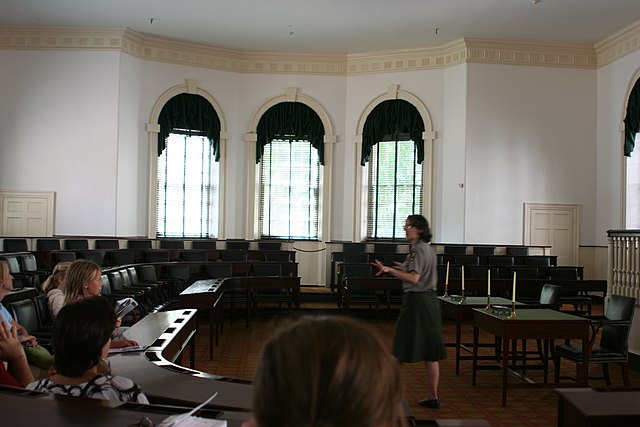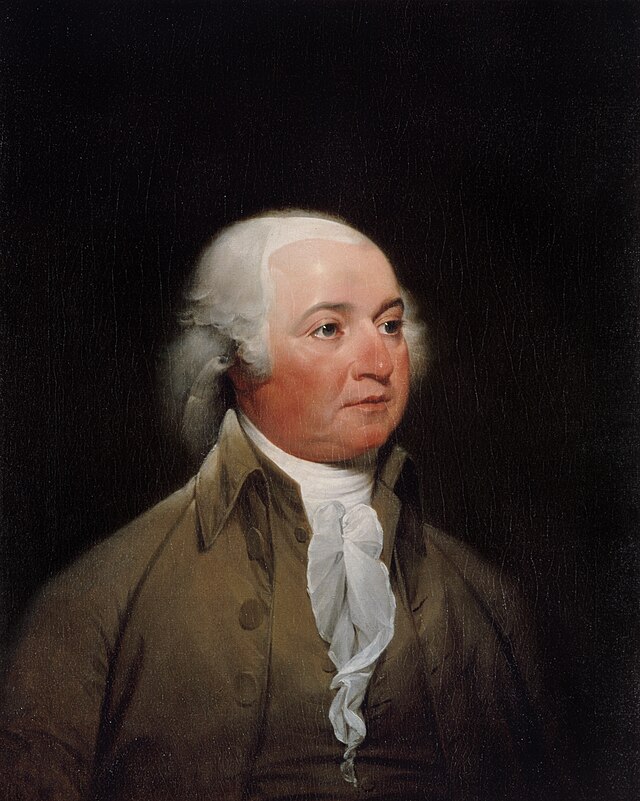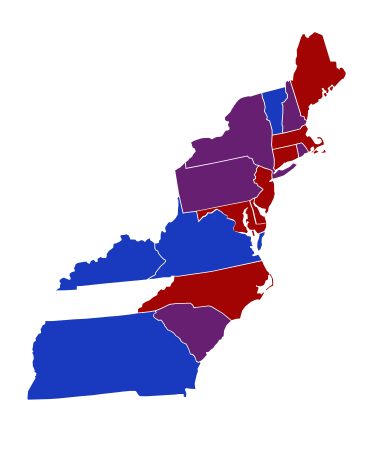Loading AI tools
Legislative term from 1791–1793 From Wikipedia, the free encyclopedia
The 2nd United States Congress, consisting of the United States Senate and the United States House of Representatives, met at Congress Hall in Philadelphia, Pennsylvania, from March 4, 1791, to March 4, 1793, during the third and fourth years of George Washington's presidency. The apportionment of seats in the House of Representatives was based on the provisions of Article I, Section 2, Clause 3 of the United States Constitution. Additional House seats were assigned to the two new states of Vermont and Kentucky. Both chambers had a Pro-Administration majority.
| 2nd United States Congress | |
|---|---|
1st ← → 3rd | |
 Congress Hall (2007) | |
March 4, 1791 – March 3, 1793 | |
| Members | 26–30 senators 65-69 representatives |
| Senate majority | Pro-Administration |
| Senate President | John Adams (P) |
| House majority | Pro-Administration |
| House Speaker | Jonathan Trumbull Jr. (P) |
| Sessions | |
| Special: March 4, 1791 – March 4, 1791 1st: October 24, 1791 – May 8, 1792 2nd: November 5, 1792 – March 2, 1793 | |


There were no political parties in this Congress. Members are informally grouped into factions of similar interest, based on an analysis of their voting record.[1]
Details on changes are shown below in the "Changes in membership" section.
During this congress, two new Senate seats were added for each of the new states of Vermont and Kentucky.
| Faction (Shading indicates faction control) |
Total | ||||
|---|---|---|---|---|---|
| Anti-Administration (A) |
Pro-Administration (P) |
Vacant | |||
| End of previous Congress |
8 | 18 | 26 | 0 | |
| Begin | 8 | 17 | 25 | 1 | |
| March 4, 1791[a] | 16 | 24 | 2 | ||
| June 13, 1791[b] | 17 | 25 | 1 | ||
| November 4, 1791[c] | 10 | 27 | |||
| June 18, 1792[d] | 12 | 29 | |||
| October 8, 1792[e] | 11 | 28 | 2 | ||
| October 18, 1792[f] | 12 | 29 | 1 | ||
| November 30, 1792[g] | 16 | 28 | 2 | ||
| January 10, 1793[h] | 17 | 29 | 1 | ||
| February 28, 1793[i] | 13 | 30 | 0 | ||
| Final voting share | 43.3% | 56.7% | |||
| Beginning of the next Congress |
14 | 16 | 30 | 0 | |

During this congress, two new House seats were added for each of the new states of Vermont and Kentucky. (Sess. 3, ch. 9, 1 Stat. 191)
| Faction (Shading indicates faction control) |
Total | ||||
|---|---|---|---|---|---|
| Anti-Administration (A) |
Pro-Administration (P) |
Vacant | |||
| End of previous Congress |
28 | 36 | 64 | 1 | |
| Begin March 4, 1791 |
25 | 37 | 62 | 3 | |
| April 4, 1791[j] | 38 | 63 | 2 | ||
| October 24, 1791[k] | 28 | 66 | 1 | ||
| November 1791[l] | 37 | 65 | 2 | ||
| February 6, 1792 [m] | 29 | 66 | 1 | ||
| March 21, 1792[n] | 28 | 65 | 2 | ||
| April 2, 1792[o] | 38 | 66 | 1 | ||
| June 1, 1792[p] | 27 | 65 | 4 | ||
| November 8, 1792[q] | 28 | 66 | 3 | ||
| November 9, 1792[r] | 29 | 67 | 2 | ||
| November 22, 1792[s] | 30 | 68 | 1 | ||
| December 6, 1792[t] | 29 | 67 | 2 | ||
| January 30, 1793[u] | 39 | 68 | 1 | ||
| Final voting share | 42.6% | 57.4% | |||
| Beginning of the next Congress |
55 | 50 | 105 | 0 | |

This list is arranged by chamber, then by state. Senators are listed by class, and representatives are listed by district.
Senators were elected by the state legislatures every two years, with one-third beginning new six-year terms with each Congress. Preceding the names in the list below are Senate class numbers, which indicate the cycle of their election. In this Congress, Class 1 meant their term began in this Congress, facing re-election in 1796; Class 2 meant their term ended with this Congress, facing re-election in 1792; and Class 3 meant their term began in the last Congress, facing re-election in 1794.
Connecticut
Delaware
Georgia
Kentucky
Maryland
Massachusetts
New Hampshire
New Jersey
|
New York
North Carolina
Pennsylvania
Rhode Island
South Carolina
Vermont
Virginia
|
 2 Anti-Administration
1 Anti-Administration and 1 Pro-Administration
2 Pro-Administration |

|
The names of members of the House of Representatives are preceded by their districts.
There were no political parties in this Congress. Members are informally grouped into factions of similar interest, based on an analysis of their voting record.[1]
Vermont and Kentucky were newly admitted as states and are first represented in this Congress.
There were three resignations, one contested election, and four new seats of admitted states, resulting in a four-seat net gain of the Anti-Administration Senators.
| State (class) |
Vacated by | Reason for change | Successor | Date of successor's formal installation[v] |
|---|---|---|---|---|
| Pennsylvania (1) |
Vacant | Legislature failed to elect senator. Successor elected February 28, 1793. |
Albert Gallatin (A) | December 2, 1793 |
| Connecticut (3) |
William S. Johnson (P) | Resigned March 4, 1791. Successor elected June 13, 1791. |
Roger Sherman (P) | June 13, 1791 |
| Vermont (3) |
New seat | Vermont was admitted to the Union March 4, 1791. Winners elected October 17, 1791. |
Stephen R. Bradley (A) | November 4, 1791 |
| Vermont (1) |
Moses Robinson (A) | November 4, 1791 | ||
| Kentucky (3) |
New seat | Kentucky was admitted to the Union June 1, 1792. Winners elected June 18, 1792. |
John Edwards (A) | June 18, 1792 |
| Kentucky (2) |
John Brown (A) | June 18, 1792 | ||
| Virginia (2) |
Richard Henry Lee (A) | Resigned October 8, 1792. Successor elected October 18, 1792. |
John Taylor (A) | October 18, 1792 |
| Maryland (1) |
Charles Carroll (P) | Resigned November 30, 1792. Successor elected January 10, 1793. |
Richard Potts (P) | January 10, 1793 |
There were 3 resignations, 1 vacancy of a member-elect, 1 contested election, 2 late elections, and 4 new seats of admitted states, resulting in a 3-seat net gain of the Anti-Administration members and a 1-seat net gain of the Pro-Administration members.
| District | Vacated by | Reason for change | Successor | Date of successor's formal installation[v] |
|---|---|---|---|---|
| Massachusetts 8th | Vacant | Due to failure to reach a majority, four ballots were needed to elect. Incumbent was elected late April 4, 1791. | George Thatcher (P) | April 4, 1791 |
| New York 1st | Vacant | Representative-elect James Townsend died on May 24, 1790, before Congress assembled. | Thomas Tredwell (A) | October 24, 1791 |
| Vermont 1st | New seat | Vermont was admitted to the Union on March 4, 1791. | Israel Smith (A) | October 24, 1791 |
| Vermont 2nd | Nathaniel Niles (A) | October 24, 1791 | ||
| Maryland 3rd | William Pinkney (P) | Resigned November 1791 | John Francis Mercer (A) | February 6, 1792 |
| Massachusetts 6th | Vacant | Due to failure to reach a majority, eight ballots were needed to elect. Incumbent was elected late April 2, 1792. | George Leonard (P) | April 2, 1792 |
| Virginia 2nd | John Brown (A) | Resigned June 1, 1792, to become U.S. Senator from Kentucky. | Vacant | Seat went with Kentucky |
| Kentucky 2nd | New seat | Kentucky was admitted to the Union on June 1, 1792. | Alexander D. Orr (A) | November 8, 1792 |
| Kentucky 1st | Christopher Greenup (A) | November 9, 1792 | ||
| Georgia 1st | Anthony Wayne (A) | Anthony Wayne served until March 21, 1792, when seat declared vacant because the election was contested | John Milledge (A) | November 22, 1792 |
| Maryland 2nd | Joshua Seney (A) | Resigned December 6, 1792. | William Hindman (P) | January 30, 1793 |
Lists of committees and their party leaders.
Seamless Wikipedia browsing. On steroids.
Every time you click a link to Wikipedia, Wiktionary or Wikiquote in your browser's search results, it will show the modern Wikiwand interface.
Wikiwand extension is a five stars, simple, with minimum permission required to keep your browsing private, safe and transparent.